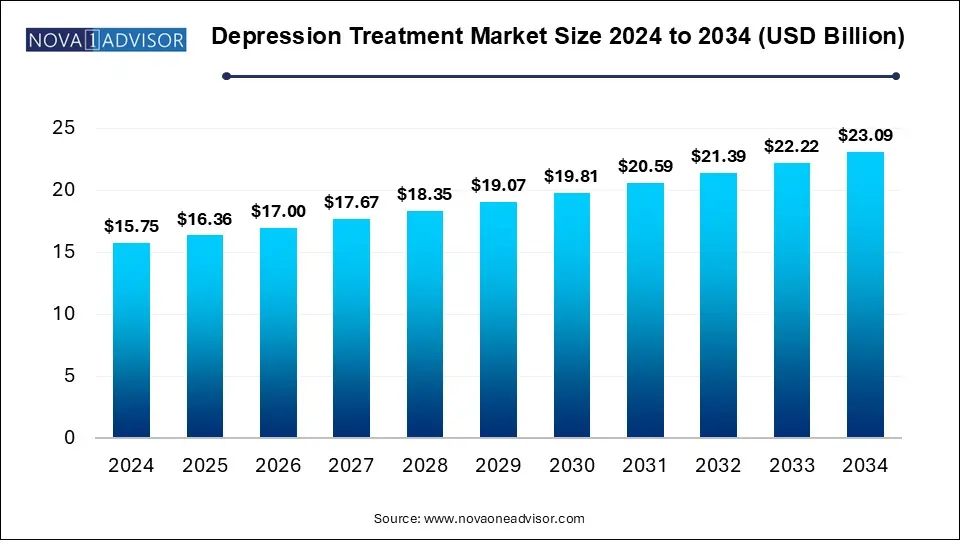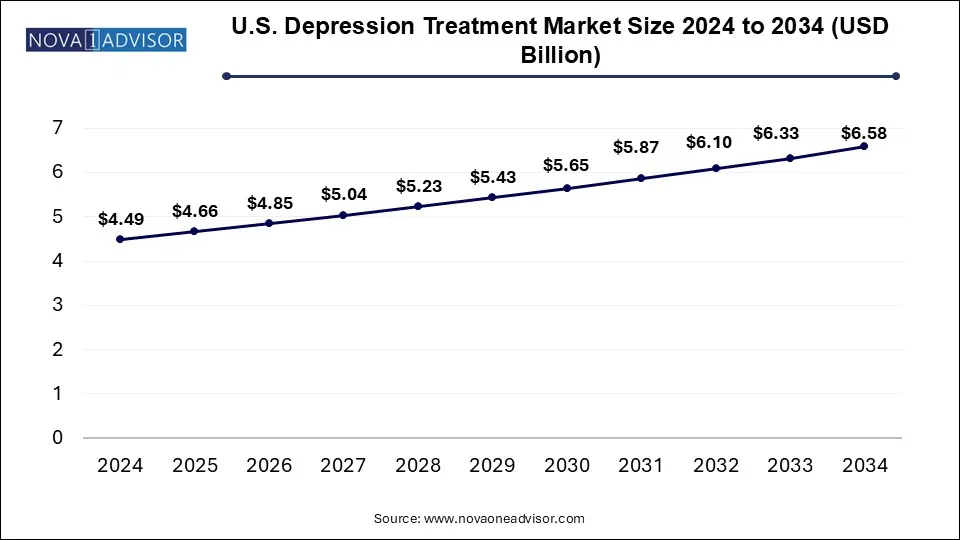Depression Treatment Market Size and Trends
The depression treatment market accounted for USD 15.75 billion in 2024 and is expected to hit around USD 23.09 billion by 2034, growing with a CAGR of 3.9% from 2025 to 2034. This market is growing due to increasing awareness, evolving therapies, and rising mental health concerns worldwide.

Depression Treatment Market Key Takeaways
- North America dominated the market with the largest market share in 2024.
- Asia Pacific is expected to expand at the fastest CAGR during the forecast period.
- By drug type, the antidepressant segment dominated the market with the highest market share in 2024.
- By drug type, the atypical antipsychotic segment is expected to witness significant growth in its market share during the predicted timeframe.
- By indication, the anxiety segment dominated the depression treatment market with the largest share in 2024.
- By indication, the depression segment dominated the market with the largest market share.
- By distribution, the retail segment held the largest share in 2024.
- By distribution, the other segment is expected to grow at the fastest rate in the market.
U.S. Depression Treatment Market Size and Growth 2025 to 2034
The U.S. depression treatment market size was valued at USD 4.49 billion in 2024 and is expected to reach around USD 6.58 billion by 2034, growing at a CAGR of 3.53% from 2025 to 2034.

North America dominates the depression treatment market, driven by the well-established healthcare infrastructure, high awareness of mental health issues, and the presence of leading pharmaceutical companies. Because so many people in the area suffer from anxiety depression and other related conditions there is a high need for efficient treatments. Accessibility is supported by government programs and extensive insurance coverage while major pharmaceutical companies advanced R&D efforts guarantee ongoing innovation. Both conventional antidepressants and cutting-edge therapies like ketamine-based treatments are widely available in North America thanks to robust distribution networks that include hospital and retail pharmacies.
Asia Pacific is seeing rapid growth in the depression treatment market, driven by a growing public awareness of mental health issues increased funding for healthcare, and a growing acceptance of psychological services. Governments are giving mental health programs top priority developing their healthcare systems and incorporating mental health services into primary care in nations like China Japan and India. Urbanization pressures at work and changes in lifestyle are examples of economic and social stressors that have increased the prevalence of depression and raised the demand for treatment options. Further expanding access to mental health care in both urban and rural areas are digital healthcare solutions like online therapy platforms and telemedicine.
Depression Treatment Market Overview
The global depression treatment market is expanding rapidly, driven by increasing awareness of mental health, a rising prevalence of depression, and advancements in treatment options. Psychotherapy digital mental health solutions and pharmaceutical innovations like ketamine-based therapies and antidepressants are driving market expansion. Demand is being further increased by government and healthcare organizations' investments in mental health infrastructure. Nonetheless, issues such as exorbitant medical expenses, social disapproval, and adverse drug reactions continue to exist. The market is anticipated to continue developing and providing more accessible and efficient treatment options as a result of continued research and technological breakthroughs.
Market Drivers
Rising Prevalence of Depression
Urbanization social isolation, financial stress, and lifestyle changes are some of the factors contributing to the steadily rising number of people receiving a diagnosis of depression. Over 280 million people worldwide suffer from depression which is one of the main causes of disability according to the WHO. The COVID-19 pandemic made mental health problems worse and increased the need for efficient treatment options. The market continues to grow as more people become aware of the symptoms and seek professional assistance.
Advancements in Treatment Options
Ketamine and psychedelic-assisted therapies are two examples of new antidepressants that are revolutionizing the treatment of depression. Genetic testing for drug compatibility is one example of personalized medicine that is improving treatment outcomes by decreasing trial-and-error prescribing. Apps for cognitive behavioral therapy (CBT) and other digital therapies are becoming more popular because they provide affordable and easily accessible options. As research goes on developments in AI-driven diagnostics, brain stimulation therapies, and microbiome-based treatments may boost market expansion even more.
Depression Treatment Market Growth Factors
Increasing Global Burden of Mental Health Disorders
Stress, social isolation, economic uncertainty, and lifestyle changes are some of the factors contributing to the steadily increasing prevalence of depression, one of the most prevalent mental health disorders in the world. According to the World Health Organization (WHO), depression affects more than 280 million people worldwide. Growing awareness of depression as a serious public health concern is fueling demand for efficient therapies and propelling market expansion.
Technological Innovations in Mental Healthcare
The diagnosis and treatment of depression are being revolutionized by the combination of digital health solutions and artificial intelligence (AI). Early intervention and ongoing monitoring are offered by AI-powered chatbots, mood-tracking applications, and virtual therapy platforms. Wearable technology with biometric sensors can monitor mood and stress levels providing real-time information for tailored care. Therapy is becoming more interesting and successful with the popularity of gamified mental wellness apps and virtual reality (VR) based exposure therapy.
Report Scope of Depression Treatment Market
| Report Coverage |
Details |
| Market Size in 2025 |
USD 16.36 Billion |
| Market Size by 2034 |
USD 23.09 Billion |
| Growth Rate From 2025 to 2034 |
CAGR of 3.9% |
| Base Year |
2024 |
| Forecast Period |
2025-2034 |
| Segments Covered |
Drug type, Indication, Distribution Channel, Region |
| Market Analysis (Terms Used) |
Value (US$ Million/Billion) or (Volume/Units) |
| Regional scope |
North America; Europe; Asia Pacific; Latin America; MEA |
| Key Companies Profiled |
Pfizer Inc.; H. Lundbeck A/S; GSK plc; Merck & Co., Inc.; Eli Lilly and Company; AstraZeneca; Bristol-Myers Squibb Company; Johnson & Johnson Services, Inc.; AbbVie Inc.; Sanofi |
Market Opportunity
Growing Demand for Personalized and Precision Medicine
Personalized treatment strategies are becoming possible thanks to developments in genetics and biomarker research. Through pharmacogenomic testing, medical professionals can customize antidepressant prescriptions according to a patient's genetic composition which minimizes trial-and-error prescribing and enhances patient outcomes. Pharmaceutical resistance, which continues to be a major obstacle in the management of depression, can be effectively addressed by businesses investing in precision medicine solutions.
Market Challenge
High Treatment Costs and Limited Accessibility
Many advanced depression treatments, including ketamine therapy, transcranial magnetic stimulation, and personalized medicine, are expensive and not widely covered by insurance. This restricts market expansion by rendering it inaccessible to a significant segment of the populace, especially in low-income areas. For patients without insurance, even traditional antidepressants and psychotherapy can be prohibitively expensive. To overcome this difficulty, it is essential to increase affordability through telehealth solutions generic medication availability, and policy changes.
Segmental Insights
Depression Treatment Market By Drug Type
Antidepressant segment held the largest share because of their excellent safety record and effectiveness. These drugs are frequently prescribed to treat post-traumatic stress disorder and obsessive-compulsive disorders. They are appropriate for a wide spectrum of patients due to their tolerability which includes fewer cardiovascular or sedative side effects. Furthermore, generic versions increase their accessibility and become the go-to option for both patients and healthcare professionals.
An atypical antipsychotic segment is expected to grow at the fastest rate in the market because it effectively treats bipolar disorder and schizophrenia while having a favorable side effect profile. However, cariprazine has become a more popular rival due to its ability to treat a variety of mental illnesses. Cariprazines position in the market for atypical antipsychotics is anticipated to grow as a result of its expanding worldwide availability and rising prescription rates.
Depression Treatment Market By Indication
Anxiety segment held the largest share in 2024. It includes disorders like panic disorder social anxiety disorder generalized anxiety disorder and different types of phobias. There is a significant need for efficient treatments because of these conditions' rising prevalence, increased awareness, and rising diagnosis rates. Anxiety disorders are becoming more common due to several factors including global events life balance issues and social pressures. As a result, the pharmaceutical industry has made anxiety-related drugs a top priority meeting the pressing need for efficient treatment options.
Depression segment is expected to grow at the fastest rate in the market motivated by the growing number of people receiving a major depressive disorder diagnosis. This rise is ascribed to increased access to healthcare services, decreased stigma, and increased awareness of mental health issues. Pharmaceutical developments have brought about novel treatments like Johnson and Johnson Spravato nasal spray which contains esketamine and provides quick relief for depression that is resistant to treatment. Strategic acquisitions such as Johnson and Johnson's acquisition of Intra-cellular Therapies Inc. show how dedicated the industry is to improving and growing the range of depression treatment options available. These changes demonstrate the market's dynamic character and its critical role in tracking the world's mental health issues.
Depression Treatment Market By Distribution
Retail pharmacies segment held the largest share in 2024. these facilities are frequently preferred by patients because they are easily accessible reliable and provide both branded and generic drugs right away. Additionally, retail pharmacies provide individualized care building solid patient-pharmacist bonds that improve medication compliance and treatment results overall.
Another segment is expected to grow at the fastest rate in the market. Direct-to-consumer advertising alternative services, community-based care primary care integration online therapy platforms, and workplace mental health initiatives are examples of expanding distribution channels. As a result of increased public awareness, the stigma associated with mental health treatment has decreased and more people are seeking treatment for depression and anxiety. Direct-to-consumer advertising has been crucial in encouraging people to seek professional care and promoting psychological therapies. Online therapy platforms and telemedicine have also made licensed professionals more accessible which is especially advantageous for younger populations. In the meantime, mental health services have been integrated into local settings by primary care physicians and community-based services guaranteeing a more thorough approach to patient needs.
Some of The Prominent Players in The Depression Treatment Market Include:
Depression Treatment Market Recent Developments
- In January 2025, Flow Neuroscience introduced a brain stimulation headset designed for home-based treatment of depression using transcranial direct current stimulation (DCS). In addition to improving accessibility and convenience, this noninvasive device offers people with mild to moderate depression a drug-free alternative. Technology enhances mood and cognitive function by adjusting neural activity.
- In May 2024, Johnson & Johnson launched a digital therapeutics platform designed to support patients with behavioral therapy for depression and anxiety. The platform integrates AI-driven therapy sessions, real-time mood tracking, and clinician support, offering a hybrid model between traditional therapy and digital mental health care.
Segments Covered in the Report
This report forecasts revenue growth at country levels and provides an analysis of the latest industry trends in each of the sub-segments from 2021 to 2034. For this study, Nova one advisor, Inc. has segmented the Depression Treatment Market
By Drug Type
- Antidepressants
- Anxiolytics
- Anticonvulsants
- Noradrenergic Agents
- Atypical Antipsychotics
By Indication
By Distribution Channel
- Hospital Pharmacies
- Retail Pharmacies
- Others
By Regional
- North America
- Europe
- Asia Pacific
- Latin America
- Middle East and Africa (MEA)


